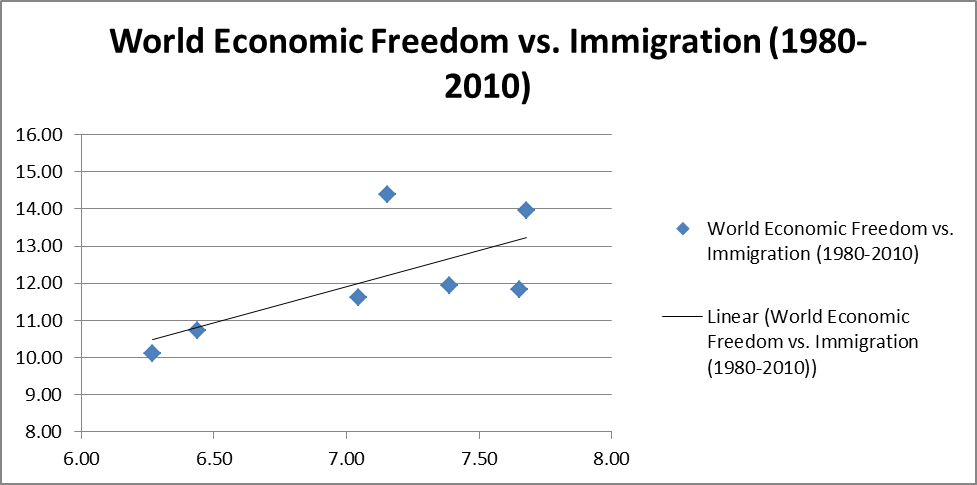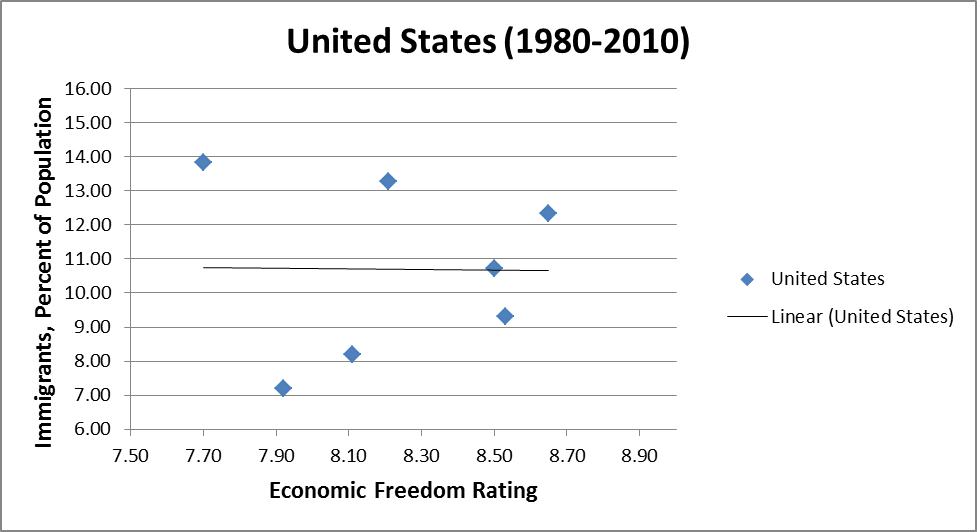Vipul Naik posted a “Lebanon and political externalities bleg” in June. His question was whether the Lebanese Civil War from 1975 to 1990 might furnish an example where immigration led to distastrous consequences for a country. Of course, Steve Sailer makes just such a point in one of his posts: “Diversity Is Strength! It’s Also … Lebanonization”. Sailer’s argument is broader as he indicts not only immigration, but diversity in general as well as differential birth rates.
That got me interested in what the relationship between immigration and civil war is. Do high levels of immigration cause or precipitate civil wars? If so, you would find more civil wars in countries with higher levels of immigration, fewer in those with less immigration. To get an idea, and no more, I did the following:
First I needed some data that do not rely on my selection of examples. For this purpose, I downloaded the “UCDP/PRIO Armed Conflict Dataset” as of July 2013. This is a dataset of all armed conflicts worldwide from 1946 to 2012 where at least one side is a state (there is also a dataset for non-state conflicts, but only with a shorter history from 1989 to 2011). The dataset not only includes civil wars, but also regular wars. There are 2098 entries, one per year of each conflict and the sometimes changing coalitions. On both sides the primary and any other combattants are listed as well as the location of the armed conflict. Since I was only interested in whether a country had had a civil war in the period, I filtered the data. There were 768 different conflicts with the same participants and location, however with some multiple counting. E. g. there were 29 armed conflicts for Afghanistan because of the changing coalitions. Next I looked which countries had had at least one conflict that was not a regular war between countries. There were now 104 countries.
To give you a flavor of what those examples are: there were 10 for Europe. Four are related to the breakup of Yugoslavia (Serbia, Croatia, Bosnia-Hercegovina, Macedonia), the UK versus various factions of the IRA, Spain versus ETA, France versus OAS, the Greek Civil War after World War II, the civil war after the fall of Ceauscescu in Romania, and Cyprus. 17 were in the Middle East and in Northern Africa, 18 in Latin America and the Carribean, 22 in Asia ex the Middle East (mostly in Central Asia and as part of the Indochinese Wars), 36 in Africa ex Northern Africa, and one for the United States vs. the Puerto Rican Nationalist Party. Not all have the feel of a “real” civil war, some like ETA in Spain could also be viewed as an extended terror campaign. But that would also be pretty bad if it were related to high levels of immigration.
Next I needed some data to quantify the level of immigration. What I took were data from the UN on International Migration from 2006, and here especially the “migrant stock” as a percentage of the population, i. e. what fraction was foreign-born. Of course, there is a problem here. Levels of migration might be influenced by civil wars: less immigration for countries with civil wars, and more for those without. However, my intent was only to get a rough idea what the relationship might be, all very tentative. And as you will see, it looks rather implausible that what I obtain is due to such an effect.
I then matched the data. There were 232 countries in the UN data set. However, there were also many tiny ones, e. g. the Holy See with 1,000 inhabitants and 100% migrant stock. I threw out all countries with less than a quarter of a million inhabitants, which reduced the number to 179 countries. There were 97 of them that had had an armed conflict. The seven that disappeared were not in the group of tiny countries, but were countries that no longer exist, e. g. South and North Vietnam, North and South Yemen, or did not yet exist in 2006 like South Sudan. The migrant stock varies from almost 0% to a high of 78.3% for Qatar.
The countries which had had an armed conflict had an average migrant stock of 4.3%, whereas those without an armed conflict had 12.7% migrant stock. Now this may be due to many small countries with high levels of immigration (e. g. the gulf states, European countries). However, also weighting with population, I calculated that countries with an armed conflict had a migrant stock of 2.2%, and those without one had a migrant stock of 6.6%. Or in other words: countries without an armed conflict had a migrant stock about three times as high as countries with an armed conflict.
In addition, I made the following evaluation. On the x-axis you see the 179 countries sorted by migrant stock from those with high percentages down to those with low ones, i.e. in decreasing order. I then summed up from left to right how many countries had armed conflicts, which is shown as the blue line. So the 50 countries to the left with the highest level of immigrants had 15 armed conflicts. All 179 countries had, of course, 97 conflicts. The blue line is rather smooth, so there is not some group with a certain level of immigration that had many armed conflicts and unduly influences the result.
As a comparison I added the red line which rises linearly from 0 to 97. If countries had an armed conflict with equal probability, then you would expect the blue line to be close to the red line. But it is not. There were only 15 armed conflicts among the first 50, but there should have been almost 27 with equal probabilities. The blue line is actually below the red line all the way, which means that there were fewer armed conflicts than equal probability for groups of countries above any threshold.
I said that there might be a problem with the effect running the other way: more armed conflict leads to less immigration. However, if you look at the specific cases, it looks rather implausible that this would change the results materially. Actually, it might make the results even stronger. E. g. the country with an armed conflict and the highest level of immigrants at 39.6% of the population is Israel. It is arguable whether that was an internal conflict at all. However, it would be a dubious claim in any way that the high level of immigration had anything to do with the situation Israel finds itself in. Probably Israel would have had the same armed conflicts with the Palestinians if there had been no immigration since 1946. In a similar vein, many of the armed conflicts in countries with high levels of immigration have no connection with immigration: the US vs. the PRNP, Spain vs. ETA, the UK vs. IRA, France vs. OAS. Or if you look at the thirty countries with the lowest migrant stock (0.5% or less), of which 24 experienced an armed conflict, it seems very hard to argue that they once had high levels of immigration that went down as a result of an armed conflict. Here are a few of the countries you would have to argue this for: Afghanistan, Peru, Guatemala, Angola, Eritrea, Haiti, Mali.
This is not to say that immigration caused lower levels of armed conflicts. In the literature on civil wars, it is often claimed that poorer countries have more civil wars than richer countries (cf. for a critical take). And richer countries will also attract more immigrants. So the true reason for both might be that a country is richer. However, if you think that immigration is a major driver of armed conflict, your claim does not look obvious and prima facie seems to be wrong. There is some research that would imply that civil wars can be contagious, i. e. can precipitate civil wars in neighboring countries and then also via a large influx of refugees (maybe Lebanon is such an example). However, if an argument along these lines can be made, its relevance is rather limited, and does not apply to the countries that typically receive immigrants. But I freely admit that my analysis can improved upon. It was just to get an idea what the relationship might be, no more.



